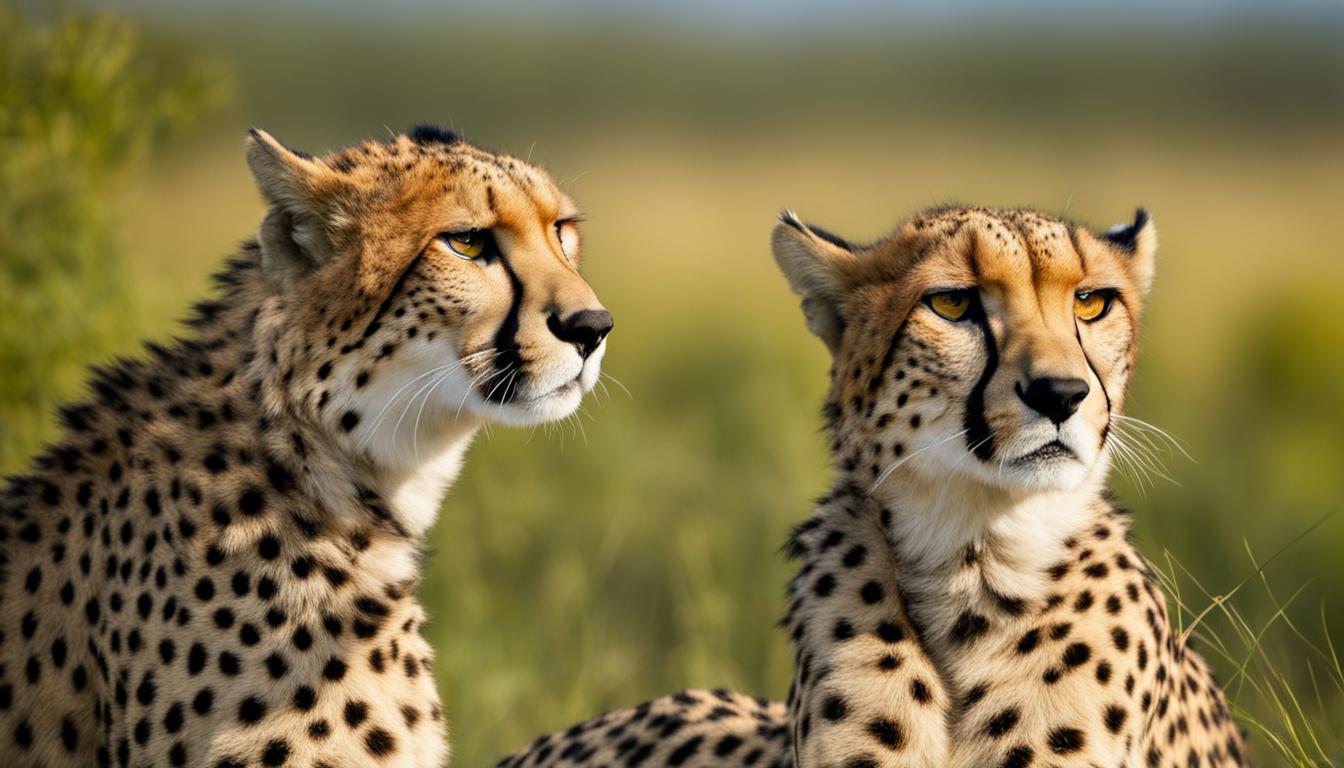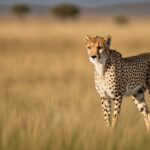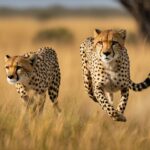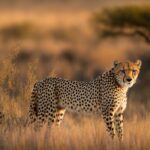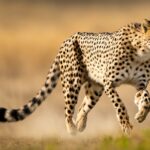Welcome to our exploration of cheetah communication in the wild. Cheetahs, known for their incredible speed and grace, also possess a fascinating ability to communicate with each other using a variety of methods. From vocalizations to nonverbal cues, cheetahs have developed unique ways to interact with their fellow felines. In this article, we will delve into the intricacies of cheetah communication, shedding light on this captivating aspect of animal behavior.
Cheetahs, being part of the feline family, share some similarities in communication techniques with other members of their kind. However, they also possess distinct characteristics that set them apart. Understanding how cheetahs communicate can offer valuable insights into their social interactions and enhance our appreciation for these magnificent creatures. So, let’s embark on a journey to unravel the secrets of cheetah communication in the wild.
Cheetah Vocalizations and Body Language
Cheetahs use a combination of vocalizations and body language to communicate with each other in the wild. Their vocal repertoire includes moans, growls, hisses, and spitting sounds, which are typically heard in combative situations. These vocalizations often escalate from moans to growls and hissing, culminating in a spitting sound. Cheetah vocalizations can be classified into pulsed sounds, tonal sounds, and noisy sounds. Each sound serves a specific purpose in conveying different messages and emotions.
Experts believe that cheetahs use their vocalizations not only to communicate with other cheetahs but also to intimidate potential threats or rivals. The intensity and frequency of the vocalizations can vary depending on the situation, with more aggressive encounters leading to louder and more forceful sounds.
In addition to vocalizations, cheetahs rely heavily on body language to convey messages. They use a combination of crouching, tail movements, and facial expressions to communicate threat, aggression, and submission. When a cheetah feels threatened or confrontational, it may crouch low to the ground with its tail twitching or flicking. This posture signals that the cheetah is ready to defend itself if necessary. On the other hand, a submissive cheetah may exhibit a relaxed body posture with its tail held high.
Understanding cheetah vocalizations and body language is essential for researchers and conservationists studying these magnificent animals. By deciphering their communication patterns, we can gain valuable insights into their social behavior, hierarchy, and overall well-being. This knowledge can help inform conservation efforts and ensure the long-term survival of this endangered species.
Table: Cheetah Vocalizations and Meanings
| Vocalization | Meaning |
|---|---|
| Moans | Expressing discomfort or mild aggression |
| Growls | Signaling more intense aggression or warning |
| Hisses | Showing annoyance or frustration |
| Spitting sounds | Indicating extreme aggression or threat |
Cheetah Territorial Marking
Cheetahs, like other felids, engage in territorial marking as a form of communication. Male cheetahs are known to mark their territories with urine, a behavior commonly observed in many species of cats. They strategically choose objects that stand out in their environment, such as trees and shrubs, to leave their scent marks.
These territorial markings serve multiple purposes. Firstly, they act as a clear indicator to other cheetahs that the area is already claimed, helping to establish and maintain boundaries. It serves as a nonverbal way for cheetahs to communicate and signify their presence to potential rivals or mates. Additionally, markings can provide valuable information about the identity and reproductive status of the cheetah that left them.
Both male and female cheetahs show interest in these markings, suggesting that they play a significant role in social interactions. Female cheetahs, in particular, may use territorial markings to assess the presence of male cheetahs and determine potential mating opportunities. Understanding these marking behaviors is crucial for gaining insights into cheetah social dynamics and their overall communication patterns.
Territorial Marking
| Type of Marking | Description |
|---|---|
| Urine Spray | Male cheetahs often spray their urine on trees and shrubs, leaving a distinct scent mark. |
| Scraping | Cheetahs may scrape the ground with their hind feet after urinating or defecating, intensifying the scent and visually marking the area. |
| Facial Rubbing | Cheetahs may rub their cheeks and chin against objects, leaving scent glands behind as they mark their territory. |
| Scat | Cheetahs may defecate in specific areas to mark their territory, leaving a strong odor that acts as a territorial boundary. |
Table: Examples of Cheetah Territorial Marking
- Urine Spray: Male cheetahs often spray their urine on trees and shrubs, leaving a distinct scent mark.
- Scraping: Cheetahs may scrape the ground with their hind feet after urinating or defecating, intensifying the scent and visually marking the area.
- Facial Rubbing: Cheetahs may rub their cheeks and chin against objects, leaving scent glands behind as they mark their territory.
- Scat: Cheetahs may defecate in specific areas to mark their territory, leaving a strong odor that acts as a territorial boundary.
Cheetahs use their sense of smell to detect and interpret these markings, allowing them to gather valuable information about the presence and status of other individuals in their vicinity. Territorial marking is an essential aspect of cheetah communication, helping to establish social hierarchies and minimize conflicts.
Cheetah Life Cycle and Social Behavior
Understanding the life cycle and social behavior of cheetahs is essential for gaining insight into their fascinating world. From the moment they are born until they reach adulthood, cheetahs go through various stages that define their development and social interactions.
The cheetah life cycle begins with cubs, who are born blind and helpless, weighing between 8.5 to 15 ounces. These adorable little creatures rely completely on their mother for survival, staying by her side for approximately 18 months. During this time, they learn vital skills such as hunting and navigating their environment.
As they enter adolescence, cheetahs may form coalitions, with male siblings sticking together for life. These coalitions provide support and companionship, enhancing their chances of survival. Female cheetahs, on the other hand, lead solitary lives unless they are accompanied by cubs. Their territories often overlap with other females and depend on the distribution of prey.
Table: Cheetah Life Cycle
| Stage | Description |
|---|---|
| Cub | Blind and helpless; reliant on mother |
| Adolescence | Possibility of forming male coalitions; learning essential survival skills |
| Adult Life | Females lead solitary lives; overlapping home ranges; dependence on prey distribution |
The social behavior of cheetahs revolves around their unique adaptations and individual characteristics. Their ability to communicate and interact with each other is crucial for maintaining social harmony and establishing territories. This behavior plays a significant role in their survival and conservation.
Through a combination of vocalizations, body language, and scent marking, cheetahs convey messages to their fellow cheetahs. Understanding these communication patterns provides researchers and conservationists with valuable insights into the behavior and needs of these magnificent creatures.
Cheetah Physical Characteristics
Cheetahs are known for their distinctive physical characteristics that set them apart from other big cats. These adaptations contribute to their remarkable speed and agility in the wild.
One key physical feature of cheetahs is their lightweight and slender body structure. Adult cheetahs typically weigh between 75 and 125 pounds, making them much lighter than other big cats such as lions and tigers. Their thin frame, narrow waist, and deep chest allow for greater flexibility and efficient movement during high-speed chases.
The cheetah’s long legs are another important adaptation for their speed. Their hind limbs are longer than their forelimbs, providing them with an extended stride that helps maximize their running capabilities. Additionally, cheetahs have semiretractable claws and specialized foot pads that provide excellent traction, enabling them to maintain stability and grip while sprinting.
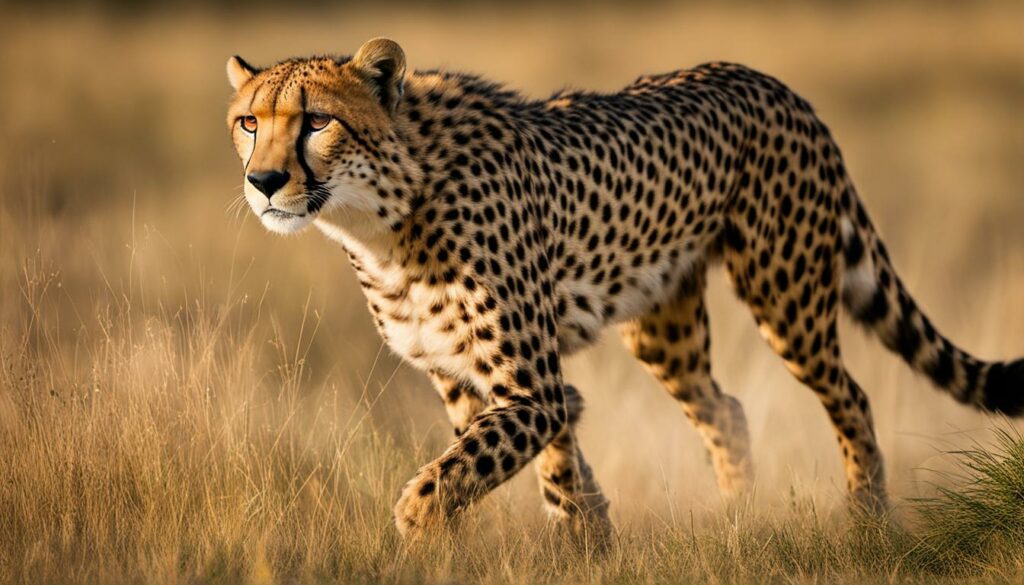
Cheetahs also possess several distinctive markings. They have solid black spots scattered across their tan-colored fur, which helps camouflage them in their natural habitat. In addition, cheetahs have tear stripes that run from the inner corner of their eyes down to the sides of their mouths. These tear stripes may serve to reduce glare from the sun and enhance their focus while hunting. Another notable feature is the bushy tuft at the end of their tail, which helps with balance and coordination during sharp turns and sudden changes in direction.
Table: Cheetah Physical Characteristics
| Physical Characteristic | Description |
|---|---|
| Weight | Between 75 and 125 pounds |
| Length | 40 to 60 inches (excluding the tail); tail adds an additional 24 to 32 inches |
| Body Structure | Slender with a narrow waist and deep chest |
| Legs | Long hind limbs for extended stride; specialized foot pads and semiretractable claws for traction |
| Markings | Solid black spots on tan fur, tear stripes from eyes to mouth, and a bushy tuft at the end of the tail |
These physical characteristics of cheetahs work in harmony to support their incredible speed and hunting capabilities, making them one of the most fascinating and unique members of the animal kingdom.
Cheetah Adaptations for Speed
Cheetahs are renowned for their incredible speed, making them the fastest land animals on Earth. Their unique adaptations enable them to reach speeds of over 110 kilometers per hour in just a matter of seconds. These adaptations involve various aspects of their anatomy and physiology, all working together to optimize their speed and agility.
One of the key adaptations of cheetahs is their specialized body structure. They have a lightweight frame, with a slim waist and elongated limbs. This streamlined physique reduces air resistance and allows them to move more efficiently. Additionally, their flexible spine and long legs provide an extended stride length, enabling them to cover more ground with each step.
Their long, muscular tail serves as a rudder, providing balance and stability during high-speed pursuits. It acts as a counterbalance, allowing cheetahs to make quick and sharp turns while maintaining their momentum. This adaptation is crucial as they navigate the unpredictable terrain of their habitat.
| Adaptation | Description |
|---|---|
| Muscular Body | Cheetahs have a lean, muscular body that allows for rapid acceleration and quick bursts of speed. |
| Long Legs | Their long legs provide an extended stride length, enabling them to cover more ground with each step. |
| Flexible Spine | A flexible spine allows for increased stride length and improved agility during high-speed chases. |
| Large Nostrils | Cheetahs have large nostrils that enhance oxygen intake, supporting their high-energy bursts of speed. |
| Semi-Retractable Claws | Their semi-retractable claws provide better traction and grip on the ground, aiding in acceleration and maneuvering. |
Furthermore, cheetahs possess specialized muscles that enable them to achieve remarkable acceleration. These muscles are highly efficient and generate immense power, allowing cheetahs to swiftly chase down their prey. Their foot pads have a unique design that offers excellent traction, enabling them to maintain control and grip on various surfaces, including sandy and grassy terrain.
In conclusion, cheetahs have an impressive array of adaptations that contribute to their exceptional speed. Their lightweight bodies, flexible spines, long legs, and muscular tails are all optimized for rapid acceleration and agile movement. These adaptations, combined with specialized muscles, foot pads, and semi-retractable claws, make the cheetah a true marvel of nature’s design.
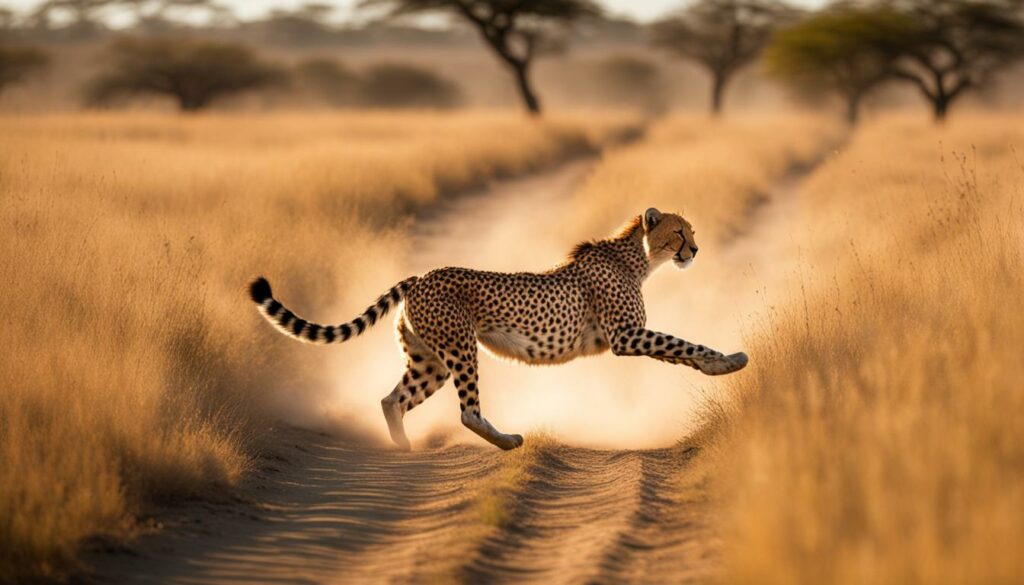
Cheetah Cubs and Family Structure
The cheetah cubs are an integral part of the cheetah family structure. These adorable little felines are born blind and completely dependent on their mother for survival. Weighing only 8.5 to 15 ounces at birth, they are carefully nurtured by their mother for about 18 months. During this time, the cubs learn essential skills, such as hunting, that will enable them to thrive in the wild.
Female cheetahs lead solitary lives unless accompanied by cubs, while male siblings form coalitions that last a lifetime. This unique family structure allows the male cheetahs to support and protect each other, increasing their chances of survival. These coalitions of brothers work together to establish and defend territories, ensuring access to resources and increasing their chances of successful mating.
It is interesting to note that female cheetahs have overlapping home ranges that depend on prey distribution. This means that multiple females may share territories, creating a complex social dynamic among female cheetahs. By sharing territories, they can maximize their hunting opportunities and create a sense of security for themselves and their cubs.
| Key Points | |
|---|---|
| Cheetah cubs are born blind and weigh 8.5 to 15 ounces. | Female cheetahs lead solitary lives unless accompanied by cubs. |
| Male cheetah siblings form coalitions that last a lifetime. | Female cheetahs have overlapping home ranges. |
In this section, we explored the significance of cheetah cubs in the overall family structure of cheetahs. From their dependence on their mother to the formation of coalitions among male siblings, each aspect contributes to the survival and success of the species. By understanding the intricate dynamics of cheetah families, we can gain valuable insights into their behavior and work towards conserving their populations for future generations.
Can Cheetah Communication Play a Role in Their Social Behavior in the Wild?
Cheetah social behavior exploration is crucial in understanding how these animals interact in the wild. Communication among cheetahs, including vocalizations, body language, and scent marking, plays a significant role in their social dynamics. By studying their communication methods, researchers can gain valuable insight into their social behavior and group dynamics.
Do Cheetahs Use Communication to Establish and Defend Their Territories in the Wild?
Cheetahs use various forms of communication when it comes to establishing cheetah territories. They use scent marking, vocalizations, and visual displays to make their presence known to other cheetahs and defend their territory from intruders. This helps them avoid confrontations and maintain their hunting grounds.
Conclusion
Understanding cheetah communication is key to comprehending their social behavior and improving conservation efforts for this remarkable species. Cheetahs utilize a combination of vocalizations, body language, and scent marking to communicate with each other in the wild.
Through their diverse vocal repertoire, which includes growls, purrs, chirps, and explosive yelps, cheetahs convey various messages to their counterparts. These vocalizations can be heard from significant distances, facilitating communication across vast territories.
In addition to vocal cues, cheetahs rely on body language to express threat, aggression, and submission. By crouching or displaying specific postures, cheetahs convey their intentions and establish dominance within their social hierarchy.
Furthermore, scent marking plays a vital role in cheetah communication, particularly for territorial assertion and boundary establishment. Male cheetahs frequently mark prominent objects in their environment with urine, which attracts the attention of other cheetahs and helps maintain their territories.
Studying and comprehending these communication patterns allow us to gain valuable insights into cheetah behavior and ultimately contribute to the conservation of this magnificent species.
Conclusion
How do cheetahs communicate with each other in the wild?
Cheetahs communicate through a variety of vocalizations, including growls, purrs, chirps, and an explosive yelp. They also use nonverbal cues like body language and scent marking.
What are some vocalizations that cheetahs use to communicate?
Cheetahs produce a range of vocalizations, including moans, growls, hisses, and spitting sounds. These vocalizations are typically heard in combative situations and can escalate from moans to growls and hissing, culminating in a spitting sound.
How do cheetahs use body language to communicate?
Cheetahs use body language, such as crouching, to communicate threat and aggression to other cheetahs.
How do cheetahs mark their territories?
Male cheetahs mark their territories with urine, often targeting objects that stand out in their environment such as trees and shrubs. Other cheetahs, both male and female, show interest in these markings.
What is the life cycle of a cheetah?
The cheetah life cycle consists of three stages: cub, adolescence, and adult life. Cubs are born blind and helpless and stay with their mother for about 18 months to learn important survival skills.
What are the physical characteristics of cheetahs?
Adult cheetahs weigh between 75 and 125 pounds, have a thin frame with a narrow waist, deep chest, and large nostrils. They have distinctive markings, including solid black spots, tear stripes, and a bushy tuft at the end of their tail.
How fast can cheetahs run?
Cheetahs are the world’s fastest land animals, capable of reaching speeds of more than 110 kilometers per hour in just over three seconds.
What is the family structure of cheetahs?
Female cheetahs lead solitary lives unless accompanied by cubs. Male siblings often form coalitions for life.
Understanding cheetah communication, both through vocalizations and nonverbal cues, is vital to comprehend their behavior and aid in conservation efforts for these remarkable animals.

